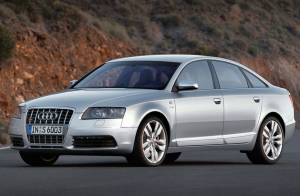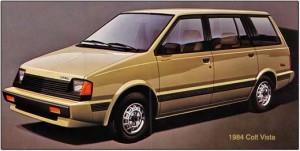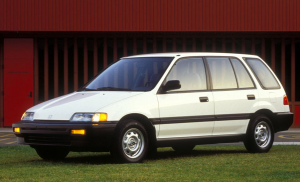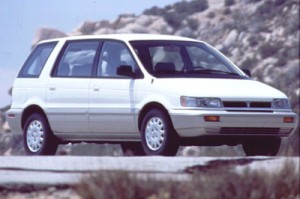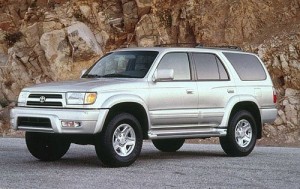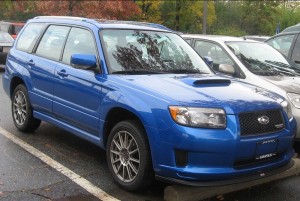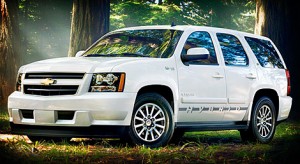Audi S6 V10: Used Car Reminder
Posted by Doug DeMuro in Used Car Reminder on | 22 comments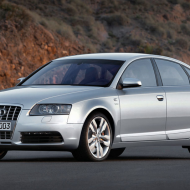
We all know Audi builds cool stuff. It’s rare that we have to be reminded of this. We remember the C4 “UrS6,” we remember the 2003 RS6 and the 2007-08 RS4, and we remember all those cars painted in that gorgeous shade of non-metallic blue that never seems to pop up on the used market. But I think many of us have forgotten this one.
By “this one,” I’m referring to the third-generation S6, which was sold from 2007 through 2011 as a sedan only. Yes, I love it even though it isn’t a high-performance wagon.
And it’s hard not to love. The main reason for this is the 5.2-liter V10 mounted under the hood, which shares most of its parts with the engine they use in the Lamborghini Gallardo. Yes, other sedans are faster and more powerful. But those may be the best bragging rights in the world.
The S6 is also lovable because it’s so damn subtle. Aside from a “V10” fender badge, some LED lights, and available upgraded wheels, you had absolutely no idea you were looking at a four-door sedan with Lamborghini power. This is a departure from most of today’s performance cars, which feature bulging fenders, and wheels, and brakes, and hoods, and basically by the end of it, every single thing they can find is bulging.
I think there are two reasons we forget this S6. One is that the A6 it was based on was so dull that most of us don’t even remember it existed. Which is completely reasonable, although I promise the S6 had an entirely different character than its lesser brethren.
But more importantly, we’re afraid it’s going to be so unreliable that we will be forced to swap in a tiny diesel motor from a European model just to keep it on the road. Fortunately, we have CarMax to worry about those problems for us. So I say, to those considering a used performance sedan: add the S6 to your shopping list. And make sure to get the warranty.
Used Car Reminder: Small 1980s Van Things
Posted by Doug DeMuro in Used Car Reminder on | 33 comments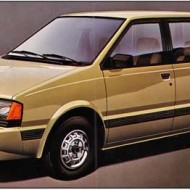
Remember the 1980s? I don’t. I only caught the tail end of the 1980s, and as a result I believe it’s my birth that was completely responsible for the demise of Communism.
Apparently, the 1980s were filled with big hair, crude video games, and that movie where Michael J. Fox visits the future, then the past, then some alternate version of the present before producers decided he was too old to play a high school student anymore.
They also included these compact minivans.
Behold the the Honda Civic WagoVan, and the Plymouth Colt Vista, all of which were popularized in the 1980s. Also shown is my personal favorite, the Mitsubishi Expo. While it lasted into the mid-1990s, the remainder of these vehicles died a premature death at the hands of consumers who didn’t really understand the idea of combining a minivan with a compact car.
Today, the Mazda5 and Ford C-MAX is the modern version of these cars. And 25 years later, consumers still don’t really understand the idea of combining a minivan with a compact car.
Interestingly, this segment is alive and well in Europe. To create these vehicles, companies simply make a van-like version of their normal compact car, then add a “Versa” or “Verso” or “MAX” to the end of the name. And voila: they sell by the thousands.
I wish we had more of these in the US, largely because the minivan is getting so big. But unfortunately, that doesn’t seem likely to happen – at least not while we still have living consumers who remember trying to keep a Colt Vista in running condition.
Supercharged Toyota 4Runner: Used Car Reminder
Posted by Doug DeMuro in Used Car Reminder on | 13 comments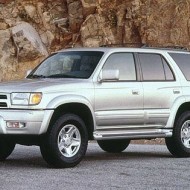
The Toyota 4Runner is a pretty cool SUV. It’s reliable, off-roadable, and even family-able. Plus, if you buy one new today it’ll still be worth exactly what you paid in about seven years. This makes looking for a used one infuriating, since a 2008 Explorer costs about the same as a 2003 4Runner. Truly.
The problem is that the 4Runner has never really been very fast. Not that you’d necessarily want it to be, since it’s tall and somewhat narrow. But for those of you who do want a spry SUV, the 4Runner was hardly the best choice.
Or was it?
From 1996 to 2002, Toyota offered a dealer-installed TRD supercharged for the 4Runner. Supposedly, this option – which cost something absurd like $3,000 – brought power from 190 horses to around 250. That’s an enormous jump, though one might argue it really brought the 4Runner from bad to normal, given the SUV’s enormous lack of power before.
Either way, I think there’s something cool about an aftermarket supercharger for a car like the 4Runner. Apparently, Toyota customers agreed, because Toyota also chose to offer a blower on the next-generation 4Runner. And then, for the next generation, Toyota chose to offer a four-cylinder. For some reason.
Finding a used one is hard. But if you do, be sure to get set of “TRD Supercharged” badges on eBay. It’s a subtle way of telling everyone: hey, now I can keep up with traffic!
Subaru Forester XT: Used Car Reminder
Posted by Doug DeMuro in Used Car Reminder on | 16 comments
Every so often, a person will come to me and ask for my advice on the best high-performance SUV. My response is always the same: why the hell would you want that?
But they usually can’t be dissuaded, until I tell them that my Range Rover gets 13 miles per gallon and it only has 300 horsepower, which means that a Mercedes ML63 AMG probably returns about the same fuel economy as a Boeing 777, while running on a similar grade of fuel.
This usually ends the discussion.
But there is at least one performance SUV that doesn’t suck down fuel like a NASCAR race: the Subaru Forester XT. Not the latest Forester XT, which is basically a hood-scooped lookalike to every other compact SUV. I’m talking about the original Forester XT, which was tremendously quick and highly attractive, even if you’re not a lesbian.
According to Subaru, the Forester XT put out 210 horsepower when it debuted in 2004. That number jumped to 230 in 2006. But Car & Driver claimed 0-to-60 in 5.3 seconds, which cast doubt on Subaru’s numbers (or, more likely, Car & Driver’s). Either way, the damn thing was fast.
It gets better. Not only did it have standard all-wheel drive, like every Subaru of the era, but the Forester XT was also available with a stick shift. And you could get it in that bright blue everyone loves. You had to paint the wheels gold yourself, though.
The only problem with the first-generation Forester XT is that it’s absolutely impossible to find one in some parts of the country. Not one exists in my hometown of Atlanta, for example, even though most high school students in Seattle are currently driving one.
Still, if you do find one, buy it: the Forester XT is the right performance SUV. And you don’t even have to own an oil refinery to keep it running.
Chevrolet Tahoe Hybrid: Used Car Reminder
Posted by Doug DeMuro in Used Car Reminder on | 9 comments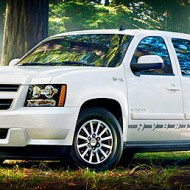
If you’re reading this site, you probably already know I’m a bit odd. For example, I’ve posted several long reviews of cars I’ve never even driven. And I once owned a Range Rover Classic. This is not normal behavior.
However, the strangest thing about me, undoubtedly, is that I love the Chevy Tahoe Hybrid.
The Tahoe Hybrid came out for the 2008 model year using a 332-horsepower 6.0-liter V8. If that sounds like a lot of power, it was: the Tahoe Hybrid did 0-60 in the mid-8 second range, which makes it a veritable monster truck of performance. (OK, maybe not, but it’s no i-MiEV, either.)
Most importantly, however, the Tahoe Hybrid boasted a huge fuel economy savings over the standard Tahoe. How huge, you wonder? According to the EPA, 20 mpg city and 23 mpg highway. I know what you’re thinking: doesn’t a semi truck get that going uphill?
OK, fine, so the Tahoe Hybrid’s gas mileage wasn’t up to i-MiEV levels either. But consider this: the standard Tahoe got 15 mpg city and 21 mpg highway. That means the hybrid’s city mpg boost was 5 mpg, or a whopping 33 percent. By comparison, the Sonata Hybrid only gets a 40 percent improvement, which means the Tahoe Hybrid is almost as green, provided you don’t look at the overall numbers.
The Tahoe Hybrid had one major problem: it was expensive. A base Tahoe costs around $40,000, while the Hybrid was closer to $54,000. Granted, no one buys a base Tahoe except for the US Forest Service, but most people could probably leave a dealer without spending more than $45,000 (or $16,000, after GM incentives). Fortunately, the Tahoe Hybrid actually added some features to compensate for its expense.
But on the used market, it’s a whole different story. Unlike me, no one respects the Tahoe Hybrid, which has brought its values to the same level as a gas-powered one. That means you can get a three-year-old Tahoe Hybrid for maybe a few grand more than a regular three-year-old Tahoe. And at that point, it’s worth it. If only so you can tell people you’re just as green as a Sonata Hybrid.
